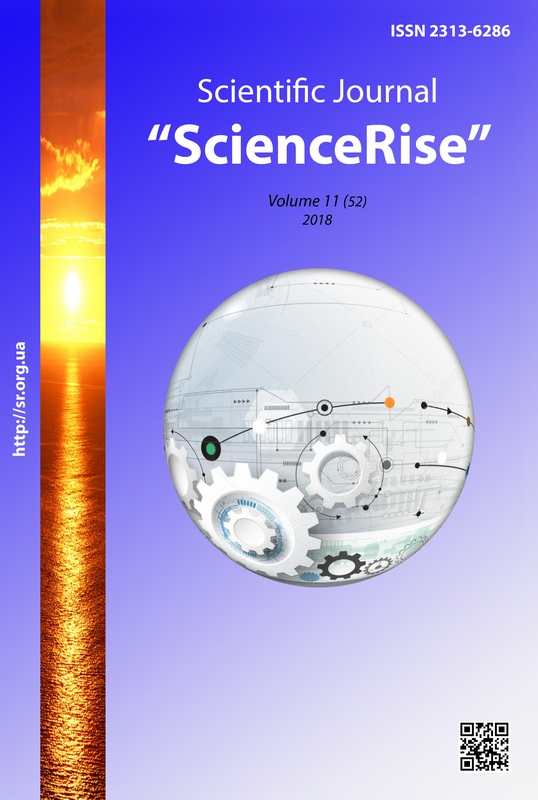Determination of dependence of indoor carbon dioxide concentration on the external concentration
DOI:
https://doi.org/10.15587/2313-8416.2018.148696Keywords:
MH-Z19 sensor, carbon dioxide, emission of pollutants, indoor air, outdoor airAbstract
The problem of determining the dependence of indoor carbon dioxide concentration, depending on the external concentration, is considered. External and internal carbon dioxide concentrations are measured using a MH-Z19 sensor.
As results of research, the data arrays of the measured external and internal concentrations of carbon dioxide are considered and analyzed. The additional factors that may affect the indoor carbon dioxide concentration are considered. The norms of indoor carbon dioxide concentration are considered and analyzed
References
Chernychenko, I. O., Pershohuba, Ya. V., Sovertkova, L. S., Balenko, N. V. (2010). Shche raz pro rol avtotransportu v zabrudnenni atmosfernoho povitria. Hihiiena naselenykh mists, 55, 150–157.
Babii, V. F., Khudova, V. M., Kondratenko, O. Ye. (2011). Nahalni problemy vplyvu suchasnoho avtotransportu na dovkillia. Hihiiena naselenykh mists, 58, 53–60.
Chidthaisong, A., Ciais, P., Cox, P. M., Dickinson, R. E., Hauglustaine, D., Heinze, C. et. al. Perturbations of the Natural Carbon Cycle from Human Activities. IPCC Fourth Assessment Report. Working Group I Report «The Physical Science Basis». Section 7.3.1.2., 514–515. Available at: http://www.ipcc.ch/pdf/assessment-report/ar4/wg1/ar4-wg1-chapter7.pdf
Shil'krot, E. O., Gubernskiy, Yu. D. (2008). Skol'ko vozdukha nuzhno cheloveku dlya komforta. AVOK, 4, 4–17.
Bo, M., Clerico, M., Pognant, F. (2016). Annoyance and disturbance hazard factors related to work and life environments: A review. Geam-Geoing. Ambient. E Mineraria-Geam-Geoengin. Environ. Min, 149, 27–34
Bo, M., Salizzoni, P., Clerico, M., Buccolieri, R. (2017). Assessment of Indoor-Outdoor Particulate Matter Air Pollution: A Review. Atmosphere, 8 (12), 136. doi: http://doi.org/10.3390/atmos8080136
Robinson, J., Nelson, W. C. (1995). National human activity pattern survey data base. Research Triangle Park, NC, US Environmental Protection Agency.
Brauer, M., Amann, M., Burnett, R. T., Cohen, A., Dentener, F., Ezzati, M. et. al. (2012). Exposure Assessment for Estimation of the Global Burden of Disease Attributable to Outdoor Air Pollution. Environmental Science & Technology, 46 (2), 652–660. doi: http://doi.org/10.1021/es2025752
Ilyushin, B. B., Mitin, I. V., Sikovskiy, D. F. (2015). Modeli funktsii plotnosti veroyatnostey dlya opisaniya rasprostraneniya primesi v konvektivnom pogranichnom sloe atmosfery. Izvestiya Tomskogo politekhnicheskogo universiteta, 326 (7: Inzhiniring georesursov), 51–59.
Ventilation for non-residential buildings – Performance requirements for ventilation and roomconditioning systems: EN 13779:2007 (2007). Brussels, 72.
Downloads
Published
Issue
Section
License
Copyright (c) 2018 Vitaliy Ivasenko, Artemii Liulevych

This work is licensed under a Creative Commons Attribution 4.0 International License.
Our journal abides by the Creative Commons CC BY copyright rights and permissions for open access journals.
Authors, who are published in this journal, agree to the following conditions:
1. The authors reserve the right to authorship of the work and pass the first publication right of this work to the journal under the terms of a Creative Commons CC BY, which allows others to freely distribute the published research with the obligatory reference to the authors of the original work and the first publication of the work in this journal.
2. The authors have the right to conclude separate supplement agreements that relate to non-exclusive work distribution in the form in which it has been published by the journal (for example, to upload the work to the online storage of the journal or publish it as part of a monograph), provided that the reference to the first publication of the work in this journal is included.

